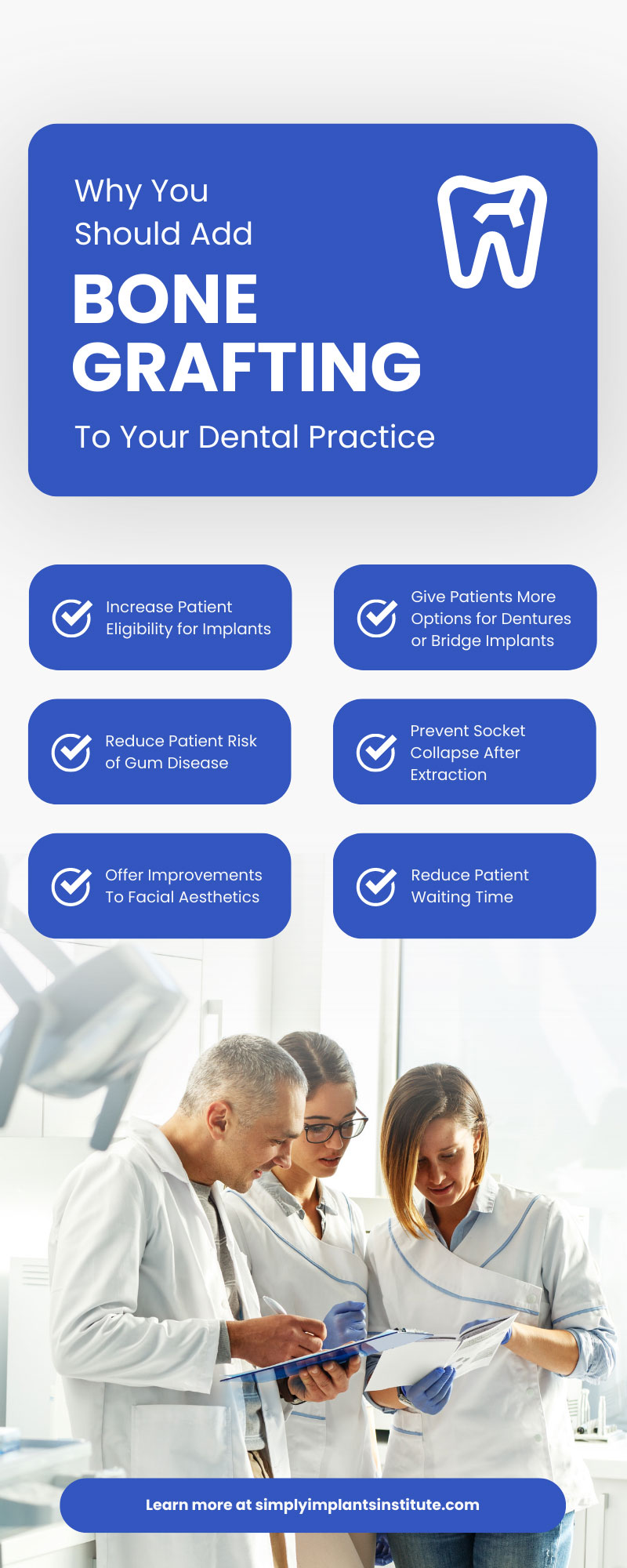Why You Should Add Bone Grafting To Your Dental Practice

Performing a bone graft procedure isn’t near the top of the list of procedures that the average person would think a dentist would do. Most people consider bone grafting to be a more serious surgical procedure, yet dentists find the need for it among the wide variety of other procedures they perform. Being a dental professional goes far beyond ensuring your patients’ teeth don’t have any cavities.
For any patient needing more in-depth reconstruction of their jawline or replacements for missing teeth, it’s very likely that bone grafting will need to take place before anything else can happen. Bone grafting in the jaw lays the strong foundation needed for a patient to have a fully healthy jawbone and a set of strong, working teeth.
If you’re on the fence about this procedure, we’ll go over why you should add bone grafting to your dental practice. At our faculty office, bone grafting is automatically part of the surgery anytime we extract a tooth. We do not make bone grafting an option. Think about it. If you buy a hamburger, it’s just assumed your burger will have a bun.
The financial benefits are obvious, but the procedure goes far beyond that by offering a ton of benefits to a wide range of patients whose jaws aren’t strong enough to support the dental work they actually need.
Increase Patient Eligibility for Implants
One of the biggest reasons to add bone grafting to your dental practice is to give more patients access to the implants they need. Whether a patient has lost a few teeth already, either due to necessary removal or an accident, or they simply weren’t born with certain important teeth, dental implants are a huge quality of life improvement for many people. Dental implants are more effective than ever at replacing real teeth, but that doesn’t mean anyone can walk in and get one as soon as they want.
Implants require a strong foundation of bone to securely hold it in place. Yet the reasons that someone may need an implant are the same reasons they will need a bone graft. Missing, damaged, or rotten teeth cause the jawbone to deteriorate, but bone grafting the jaw beforehand gives you plenty of room to place an implant once it heals.
Give Patients More Options for Dentures or Bridge Implants
Singular implants are extremely useful, but they may not be the right choice for a patient with problems throughout an entire bridge of teeth or missing too many to replace individually. Dentures and full bridge implant options are usually better choices in these cases. Patients have quite a few methods to choose from to replace an entire bridge, but not if their jaw can’t support it.
Take the All-on-Four method of bridge implants, for example. While this can be a highly effective way to replace an entire bridge of teeth, it requires four strong contact points in the jawbone to support the whole bridge. A patient experiencing heavy jawbone deterioration wouldn’t be able to choose this option without an extensive bone grafting procedure taking place first.
Reduce Patient Risk of Gum Disease
Teeth aren’t the only things at risk when the jaw’s bone structure isn’t up to snuff. Without something to support them, gums are also highly prone to developing infections and gum diseases. This issue can compound, as gum disease can also affect bone density in the same way, deteriorating the bone that the gum sits on.
Even if a patient doesn’t necessarily need a tooth implant or dentures, their gums and remaining jawbone may be at risk. By offering bone grafting procedures at your practice, you can nip this issue in the bud before it starts to get out of control and tackle the problem at its root rather than just treating the symptoms.
Prevent Socket Collapse After Extraction
Extracting teeth is commonplace for most dentists, but these extractions offer a unique opportunity to take advantage of if you offer bone grafting procedures. A tooth extraction reveals a socket that may be vulnerable to collapse if not properly cared for throughout the healing process. Bone grafting can prevent sockets from caving in by filling the void left by the extracted tooth.
Tooth extraction often comes before an implant procedure in the exact same place. If you’re prepared to do a bone graft, you can remove the unwanted tooth first, then perform the bone graft in the void left behind. Performing these procedures almost simultaneously prevents the socket from possibly collapsing and lays the foundation for the process of building up the underlying bone for the future implant.
Offer Improvements To Facial Aesthetics
Most patients care for their mouth and teeth for personal reasons beyond just maintaining their overall health. These reasons usually boil down to aesthetic preferences, such as having a nice smile, but certain dental issues can affect the aesthetics of a person’s face if left alone for too long. A deteriorating jawbone left unattended will inevitably change the way a person’s face looks and how they can move their mouth and smile.
By building up the underlying bone through bone grafting procedures, we can help our patients maintain the things they like about their faces. Offering bone grafting also offers a solution to patients whose faces have already changed in ways they don’t like because of their jawbone breaking down or after serious jaw trauma.
Reduce Patient Waiting Time
It’s hard enough to get most patients to visit the dentist as regularly as they should. Reducing the number of appointments they need to get their teeth or jaw back in working order is always beneficial. If you don’t offer bone grafting at your practice but realize that reconstruction is impossible without one, you’ll need to refer them somewhere they may not be familiar with.
This isn’t ideal for most patients and can cause unnecessary stress and anxiety, possibly enough that they would refuse the procedure to avoid the hassle. Keeping your bone grafting in-house makes it simpler for patients to get the procedure done by someone they trust and reduces the amount of time they spend scheduling and waiting for appointments.
Bone grafting is immensely useful for any dentist to have in their repertoire. If you’d like to improve your skills through dental bone grafting courses, Simply Implants Institute is your most reliable source for hands-on training. You’ll leave our course feeling confident in your ability to recommend and perform bone grafting procedures.

